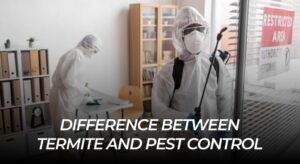Bed bugs are the silent killers that could make your peaceful sleep sound like a nightmare. These are small parasites that act as excellent hitchhikers, moving through hotels to homes undetectably. Bed bugs might reside in homes or apartments without the knowledge of homeowners or occupants, lasting up to weeks or months.
This will help delay the effects and allow easy treatment to avoid the prevalence of infestation. The faster you detect the presence of bed bugs, the sooner it will be cheaper and less involved to get rid of them. This guide will inform you what and where to look.
What Are Bed Bugs?
Bed bugs are small, oval-shaped insects that feed exclusively on the blood of humans and animals. When fully grown, they are reddish- brown and are about the size of an apple seed. The nocturnal pest will perfectly camouflage in the tiny crevices and crevices on your house.
Adult bed bugs are especially sturdy pests since they may live months without a meal. They breed fast, and females lay up to five eggs every day in a secretive place. They have flat bodies enabling them to fit in little gaps as small as a credit card.
How Can You Tell If You Have Bed Bugs?
The most apparent symptoms of bed bugs are waking up to find unexplained bites on their skin. These bites would normally come in groups or lines on exposed areas such as the arms, shoulders, and neck. The integration of the bites is usually itchy and can progress to red welts over hours. You can also hire a bed bug inspection team.
But adults who react to bed bug bites are not the only people who react; therefore, a lack of bites does not mean that a home is clear of bugs. Other individuals do not exhibit any signs of bites for days or weeks. The bed bug bites may be confused with mosquito bites or other insect bite marks by other people.
Signs of a Bed Bug Infestation
Physical Evidence on Bedding
Bed bugs also leave behind dark or rust colored stains on the sheets and pillowcases, and this is a clear indication of their presence. These are stains that are caused by crushed bugs or excretory products of the bed bug during a feed. There are also traces of small spots of blood on the sheet covers in the case of fresh bite wounds.
Bedrooms where musty sweet smells are present may also be home to a large number of bed bugs. These bed bugs have a characteristic scent, which is more pronounced when there are higher proportions of the bugs. Blood spots usually have small, dark red marks on the sheets, even when it is fresh.
Live Bugs and Shed Skins
Adult bed bugs can be seen with the naked eye, particularly when they have fed and distended. They do not move fast and prefer to stay in the bottoms of mattresses, bed frames, and headboards. Check closely in mattress labels and in the corners of those points where the material joins.
The nymphs of bed bugs undergo five molts to mature, leaving translucent shells. These discarded skins will be near hideouts and feeding spots. New shed skins are light tan or transparent and retain the shape of an oval bug body.
Bite Patterns and Reactions
The bites of the bed bug tend to be in triads or referred to as breakfast, lunch, and dinner patterns. The bites are found on exposed skin, often during sleep, as bites on the limbs (arms, shoulders), neck, and face. The bites could be either perpendicular lines or groups, depending on the way you moved in bed.
There is great variation in bite resulting in such reactions that some individuals would have red welts on the bite immediately, and some delayed reactions. The bite is typically painless when it first occurs, but causes itching after a few hours or days. There are those who get extreme allergic reactions that will need the services of a medical doctor.
Fecal Spots and Stains
Bed bug fecal matter is about the same size as a period (.) or dark spot on the mattress, sheets, or the walls. These are stains which contain digested blood; they may be found on the body of a disposable garment, in the form of dark spots, small in size. When a damp cloth is used, the spots are then smeared.
The fecal spots are more focused on those areas where bed bugs slept in during the days, especially along seams of the mattress. Bed bugs may re-inhabit the same hideouts, so look out and probe clusters of spots instead of single marks. These are stains that enter the fabric and are quite strenuous to get rid of altogether.
Egg and Eggshells
The initial eggs of bed bugs are minute, pearl white, with an approximate size of a pinpoint. Eggs are glued by females to cracks and crevices around feeding sites to protect the egg. The presence of empty eggshells reflects successful hatching as well as the growth of bed bug populations.
Newer eggs are glossy and clear, whereas aging eggs can be less transparent and even yellowish. The eggs are also known to appear in aggregations of 10-50 and are usually hidden in folds, such as in the seams of the mattress. Seek small objects with a shape of a stadium that do not fit your bedroom setting at all.
Learn more: Hidden Dangers of Bed Bugs
Proactive Prevention
Inspection of sleeping areas is quite important and may alleviate small issues before they turn into serious infestations. Inspect the bed frame and mattress once every month, and check for the presence of bed bugs. Look out for signs of new bites and strange smells in bedrooms. Treatment is very easy and effective in case the symptoms are identified early enough.
When traveling, inspect hotel rooms before occupying them. Look under the headboard and mattress seams and upholstered beds for signs of bed bugs. Store the luggage in the bathroom during inspection because bed bugs have a smaller chance of being in the bathroom. After coming home, clean and dry cotton goods with the hot setting.
Act against Bed bugs Now
Do not allow bed bugs to dominate your house and interfere with your sleep. The key contributors that make bed bug eradication successful and avoid exorbitant professional measures are early identification and timely response.







